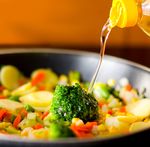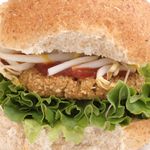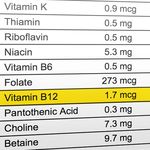Combining Vegetarian, Vegan and Gluten-Free Diets
←
→
Page content transcription
If your browser does not render page correctly, please read the page content below
RD Resources for Consumers:
Combining Vegetarian, Vegan
and Gluten-Free Diets
In celiac disease (CeD), an autoimmune disease, the protein found in wheat, rye, and barley
called gluten damages the inside of the small intestine where nutrients are absorbed. This
damage often results in poor absorption of certain nutrients before CeD is diagnosed or when
it is not treated with a gluten-free diet.
Having CeD means zero tolerance for gluten. Wheat, Vegetarians and vegans with CeD can find low-
rye, and barley are good protein sources and contain lactose or lactose-free products, calcium-rich plant
healthy nutrients, yet for those with CeD, the key to foods, and non-dairy calcium-fortified options. If
optimal health is to avoid these gluten-containing needed, choose non-dairy options (rice, almond,
foods. soy, or coconut milk) fortified with calcium, vitamin
D, and vitamin B12 that are labeled as gluten-free.
What if you are a vegetarian or vegan with CeD? Note that these non-dairy options (except for
Here are some key nutrients to keep in mind when soy) are low in protein. The Recommended Daily
combining these diets. Allowance (RDA) for calcium is 700-1300 mg for
children and teens, 1,000 mg for adult women to
Calcium and Vitamin D age 50, 1,200 mg for adult women over age 50,
Temporary lactose 1,000 mg for adult men to age 70, and 1,200 mg for
intolerance may result when adult men over age 70. If calcium needs cannot be
small intestinal damage met by food and multivitamin/mineral supplement
leads to the loss of enzymes (MVM) alone, use gluten-free calcium supplements
that digest dairy products. that contain vitamin D.
Calcium and vitamin D are Very few natural or fortified foods contain vitamin
two nutrients in dairy. A D. As many Americans have less than ideal blood
primary role for calcium is levels of this vitamin, supplements are often
to build and maintain bones recommended to meet vitamin D needs. Gluten-free
and teeth and aid in blood MVMs typically do not contain enough calcium or
clotting, nerve function, and muscle contraction. vitamin D. Ask your doctor to check your vitamin D
Vitamin D maintains normal blood levels of level and recommend the correct amount of vitamin
calcium and phosphorus to maintain strong bones. D supplementation for you.
Malabsorption of calcium and vitamin D is very
common in untreated and newly diagnosed CeD and
if CeD is not treated, can lead to bone disease.RD Resources for Consumers: Combining Vegetarian, Vegan and Gluten-Free Diets
Iron Zinc
Iron is one of the most important minerals in the Zinc, a key mineral in
human body. Its main role is to produce the protein growth and development,
that binds oxygen for delivery to the various organs. wound healing, and
Iron deficiency due to malabsorption is the most immune system health,
common symptom of recently diagnosed or untreated also supports hair, skin,
CeD. Most Americans meet their iron needs by eating and nail health. Low zinc
fortified grains, such as bread and cereals. However, levels are common in those
most gluten-free products are not iron-fortified. with newly diagnosed
Vegetarians and vegans with CeD can choose from or untreated CeD, due to
many other iron-rich plant foods to meet their needs malabsorption and persistent diarrhea. Gluten-free
(Table 1). sources of zinc include cooked dried beans and lentils,
sea vegetables, gluten-free soy foods, plain nuts and
Iron Tips: seeds, and whole gluten-free grains.
• Include iron-rich food sources in your diet.
Table 2: High Zinc Gluten-Free
• Add a vitamin C source (citrus fruit or juice, red pepper, or
tomato) to your iron-rich meal to enhance iron absorption.
Vegetarian Food
• Separate iron supplements or an iron-rich meal from calcium Food Item Serving Zinc (mg)
supplements or a calcium-rich meal by at least 2 hours as
Vegetarian baked beans, canned* ½ cup 2.9 mg
calcium and iron compete for absorption.
Yogurt, fruit 8 ounces 1.7 mg
• Tannins, which are compounds found in tea or coffee, decrease
the absorption of iron so avoid these during an iron-rich meal. Cashews, dry roasted 1 ounce 1.6 mg
• A gluten-free iron supplement or iron in a MVM is the best way Chickpeas, cooked ½ cup 1.3 mg
to ensure adequate iron intake. This is key for vegetarians and Cheese, swiss, 1 ounce 1.2 mg
vegans with CeD, especially those who are low in iron. Talk to
* Check individual products for gluten
your doctor to determine if you need a supplement.
The RDA for zinc is 3-11 mg for children and teens, 8
Table 1: High Iron Gluten-Free mg for adult women, and 11 mg for adult men. Eating
Vegetarian Food extra zinc-rich foods may be needed along with a MVM
Note: Flour, meal, and grains must be labeled gluten-free. containing 100% daily value of zinc.
Food Item
Iron fortified corn flour (masa) or corn meal
B12
Flour made from soybeans, chickpeas, buckwheat Vitamin B12 is important
Quinoa, amaranth, teff for the nervous system and
Dark leafy greens: spinach, collard greens, Swiss chard, broccoli forming red blood cells.
Lentils, chickpeas/garbanzo beans, kidney beans, lima beans Fortified grain foods, often
Soybeans, soy nuts, edamame absent in the gluten-free
Blackstrap molasses diet, are a common source
Tahini (ground sesame seeds) of B12. Vegetarians can
Plain, unseasoned cashew, almond, sunflower seeds
find B12 in dairy products,
Iron fortified gluten-free pasta, cereal, or bread
fortified non-dairy beverages labeled gluten free, eggs,
and fortified gluten-free products. Vegan diets lack
Reference: Adapted from Raymond N. The gluten-free vegetarian. In: natural food sources of B12. The recommended daily
Dennis M, Leffler D, eds. Real Life with Celiac Disease: Troubleshooting and
Thriving Gluten-Free. Bethesda, MD: AGA Press; 2010:111-118. intake of vitamin B12 for adults is 2.4 mcg. Choose
a gluten-free MVM with at least 100% daily value of
B12. Supplemental B12 may also be needed due to
malabsorption in CeD.RD Resources for Consumers: Combining Vegetarian, Vegan and Gluten-Free Diets
Table 3: Hidden Sources of Gluten
Food Item Likely Gluten-Free Not Gluten-Free
Seasoned, flavored, marinated, or baked made with
Tofu Plain tofu, packed in water
soy sauce; made with wheat gluten
Seitan None All forms of seitan are made from wheat gluten
Vegetarian Burgers, Hot Dogs, and other meat Certain varieties may be gluten-free; check Most meat substitutes contain wheat protein and
analogs individual products soy sauce
Multigrain tempeh made with wheat and barley;
Tempeh (fermented soybeans compacted into a firm Traditional, plain tempeh, made only with
seasoned or flavored tempeh products made with
cake) soybeans, rice, and tempeh culture
soy sauce
A few Quorn products, such as turkey Most Quorn products contain wheat breading or
Mycoprotein products (sold as Quorn)
substitute, may be gluten-free textured wheat protein
Plain, unflavored, textured 100% soy
Almost all flavored TVP products contain hydrolyzed
Textured vegetable protein (TVP)/soy protein protein (can be used to increase the protein
wheat or other gluten-containing ingredients
content of foods)
Most are gluten-free; must be labeled Some brands contain malted wheat and barley
Soy, rice, or almond milk
gluten-free extracts
Miso made from rice, millet, amaranth,
Miso (paste from fermented beans and grains) Miso made with wheat, barley, or rye
quinoa or buckwheat (labeled gluten-free)
Reference: Adapted from Raymond N. The gluten-free vegetarian. In: Dennis M, Leffler D, eds. Real Life with Celiac Disease: Troubleshooting and Thriving
Gluten-Free. Bethesda, MD: AGA Press; 2010:111-118.
Fiber and Protein Useful Resource Books
Fiber intake is often low in the gluten-free diet. Increase • Real Life with Celiac Disease: Troubleshooting and Thriving
it through a variety of fruits, vegetables, legumes, plain Gluten-Free by Melinda Dennis, MS, RD, LDN and Daniel Leffler
MD, 2010.
nuts and seeds, and whole gluten-free grains in the
daily diet. • 125 Gluten-Free Vegetarian Recipes by Carol Fenster, 2011.
Protein needs can be met by eating a wide variety of Online Resources
plant foods over the course of each day.
www.VegetarianNutrition.net
Where is Gluten Hidden? Frequently Asked Questions
Gluten is commonly found in processed vegetarian and • Does a vegetarian or vegan diet provide adequate protein,
vegan foods such as “meat” and soy products (see Table calcium, or other nutrients?
3). Be sure to read labels carefully. • Does a total vegetarian get enough Vitamin B12?
• Zinc in vegetarian diets
Discuss your specific diet with your doctor and a
registered dietitian nutritionist (RDN). Your doctor will
likely check your levels of iron, vitamin D, calcium, B12,
folate, and zinc. An RDN can help you develop a healthy
gluten-free vegetarian/vegan eating plan that meets
your needs. To find an RDN in your area, visit
www.eatright.org
RD Resources are a project of the Vegetarian Nutrition Dietetic Practice Group. More topics available at
www.VegetarianNutrition.net. Professional resources also available for members at www.VNDPG.org. © 2014 by VN DPG.
Written by: Melinda Dennis, MS, RD, LDN
Expires July 2019.You can also read























































